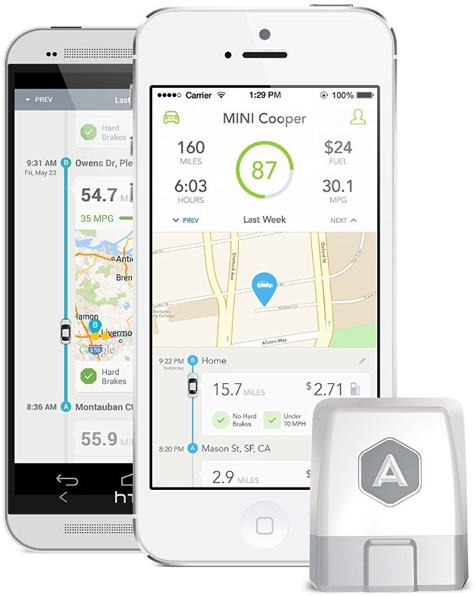Automatic Smart Driving Assistant

Monitors your driving behavior for safety and savings
The “quantified self” personal measurement tools all seem too constricting to me, at least at this point in my life. But, as one who cringed when I needed to buy my late-model Mazda3 for a commute, the concept of a “quantified car” makes a lot more sense. Buying a car means investing a decent sum of money in a depreciating collection of metal that requires sizable ongoing investments. Even when experiencing the joy of the open road, I’m still haunted by how much this contraption costs me.
So, to ease my heartburn over car ownership, I bought the Automatic “Smart Driving Assistant” just after the holidays. Intrigued by early reviews that I read on sites like TechCrunch and Engadget, I put it on my wish list and ended up buying it with some holiday cash. Spending $100 to get data on your car’s operation, your driving habits and your overall driving quality seems prudent. When that $100 also allows you to benefit from ever-improving software linked to your car’s data, it seems like a bargain. Of course, this assumes that Automatic delivers on its promise.
At present, Automatic is a simple dongle that attaches to your vehicle’s OBD-II port (every car since 1996 has one, apparently). The Automatic dongle samples your vehicle’s speed, fuel efficiency (MPG) and uses an accelerometer to measure your acceleration and braking. If your car has a mechanical problem known to the car’s computer, the Automatic dongle can read the OBD-II code, as well. The dongle then beams that data to your smartphone, using bluetooth, and an associated app then uses your smartphone to analyze and synthesize the dongle data; track your driving route and parking location; and guess at your overall fuel cost (based again on location).
The Automatic Smartphone app is simple but polished. The app presents the MPG, distance and driving habit data per trip; as well as total miles driven, hours spent, estimated fuel cost and average MPG for each week. Featured prominently is your score: a measure from 1-100, which penalizes hard brakes (measured by the accelerometer), hard “accels” (ditto) and minutes over 70 miles per hour. Your scores are calculated daily (Last day = 100!) and weekly (Last week = 98; four hard brakes in city driving screwed me!).
While it’s easy to pick at small flaws with Automatic – isn’t 70 mph arbitrary? why is the route imprecise? what if my hard brakes were the fault of other drivers? – my experience has been: it’s working. I’m now obsessed with avoiding hard brakes and hard accelerations. I scrutinize MPG numbers after each trip, wondering how I can improve it the next time. I brag about my high score to my wife. And, though I still cringe at the potential cost, I’m looking forward to reading the code on my first “check engine” light without taking my car into a mechanic.
I’m hoping that the app will continue to pay dividends. There is a “crash alert” feature, in beta, that duplicates some of the features on more expensive cars. Automatic has published an API, in alpha, which could lead to some awesome other applications. It just announced an integration with IFTTT.com, which allows for user-friendly API access. And, as Horace Dedieu has discussed on his “Asymcar” podcast, a real promise of apps like Automatic is in reselling the car. If a used car seller can document their good driving habits, the car’s performance and their maintenance record (down to the trip) it could help the buyer and the seller.
I’ve got generalized privacy concerns, but they’d apply to most “quantified” gadgets and I view my car as the least personal item I own. Automatic could also, ultimately, let users down. But, for now, the promise of a car quantified through Automatic is soothing my concerns about automotive ownership.
01/21/15Automatic Smart Driving Assistant $99






